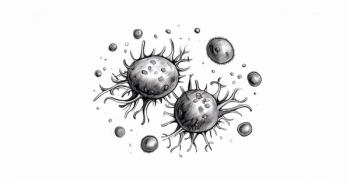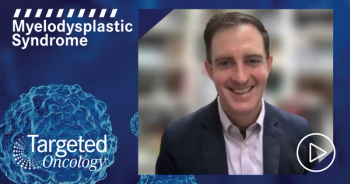
Fedratinib Shows Promise in Long-Term MPN Success With Tolerable Toxicity
Hany Elmariah, MD, discusses dose-limiting toxicities of fedratinib in a phase 1 study exploring the drug in patients with myeloproliferative neoplasms after HCT.
A phase 1 trial investigated the safety and tolerability of maintenance therapy with the JAK2 inhibitor fedratinib (Inrebic) following allogeneic hematopoietic cell transplant (HCT) for myeloproliferative neoplasms (MPNs) and myelodysplastic syndrome/MPN overlap syndromes.
While HCT offers potential cure for MPNs,
"Usually with fedratinib, the main toxicities are cytopenia, so low blood counts. We also see a fair amount of [gastrointestinal (GI)] toxicity, nausea, vomiting, or diarrhea," said Hany Elmariah, MD, associate member at the Moffitt Cancer Center in the Department of Bone Marrow Transplant and Cellular Immunotherapy, in an interview with Targeted OncologyTM.
The study enrolled patients post-HCT who received fedratinib between days +60 and +100 for up to 1 year. The trial utilized a 3+3 design to determine the maximum tolerated dose (MTD). Eleven patients were evaluable for dose-limiting toxicities (DLTs). The MTD was identified as 400 mg daily. While no DLTs occurred within the 30-day window, 4 patients withdrew due to non-DLT adverse events. Notably, only 1 patient developed severe chronic GVHD. The median progression-free survival was 12.4 months, and the 1-year overall survival was 100%.
"So we did have a fair number of grade 3 and actually 1 patient with grade 4 cytopenias. And that's significant because the way we had defined our dose-limiting toxicities to determine the maximum tolerated dose was if they had grade 3 and organ damage. So any any grade 3 toxicity, but for cytopenias, because we expect some amount, we limited it to grade 4 being a dose-limiting toxicity," Elmariah explained.
"The nausea, vomiting, diarrhea, we only saw grades 1 and 2, and we didn't have any other dose-limiting toxicities other than that. One patient that I mentioned, at least within the 30-day dose-limiting toxicity window," Elmariah added.
The conclusion of this phase I trial is that fedratinib 400 mg daily is safe as maintenance after allogeneic HCT.
"We did have some patients who came off of the study just because they were having [adverse] effects. And not that they were required to come off the study based on the protocol, but that they made the decision that they didn't want to continue because they had nausea, or that their blood levels were going down," Elmariah said.
A phase 2 expansion cohort is currently enrolling to further evaluate the long-term safety and efficacy of this maintenance strategy in preventing relapse and GVHD in MPN patients post-HCT.










































